Higher Order Thinking Skills and Visual Representations of Chemical Concepts: A Literature Review
DOI:
https://doi.org/10.33394/hjkk.v11i6.10173Keywords:
multiple visual representation, modeling, chemistry, and higher order thinking skillsAbstract
Efforts to assist students in understanding generally abstract chemical concepts are widely done using visual representations as a form of multiple representations in chemistry. This article evaluates and identifies articles from the year (2013-2023) through search engines that provide international services and national journal pages that can be accessed using 4 databases, namely, science direct, eric, google scholar, and crossref. Based on predefined criteria for the use of visual representation in chemistry to improve Higher Order Thinking Skills, 13 relevant articles were obtained. The results of the review show that visual representation can be utilized to train and improve higher-order thinking skills, especially critical, logical, reflective, metacognitive, and creative thinking. Visual representation has also been applied to several approaches or learning models such as Multiple Representation, Particulate Representation, 5R, SWH, Marzano's Taxonomy, Use of Concept Maps, and PcBL.
References
A Ghani, I. B., Ibrahim, N. H., Yahaya, N. A., & Surif, J. (2016). Enhancing Students' HOTS in Laboratory Educational Activity by using Concept Map as an Assessment Tool. Chemistry Education Research and Practice, 1-12.
Abdurrahman, A., Setyaningsih, C. A., & Jalmo, T. (2019). Implementating Multiple Representation-Based Worksheet to Develop Critical Thinking Skills. Journal of Turkish Science Education, 16(1), 138-155.
Arcavi, A. (2003). The Role of Visual Representations in the Learning of Mathematics. Proceedings International Group for the Psychology of Mathematics Education, 52, 215-241.
Baptista, M., Martins, I., Conceicao, T., & Reis, P. (2019). Multiple Representations in the Development of Students' Cognitive Structure About the Saponification Reaction. Chemistry Education Research and Practice. doi:10.1039/c9rp00018f
Berg, A., Orraryd, D., Pettersson, A. J., & Hulten, M. (2019). Representational Challenges in Animated Chemistry: Self-Generated Animations as a Means to Encourage Students' Reflections on Sub-Micro Processes in Laboratory Exercises. Chemistry Education Research and Practice. doi:10.1039/c8rp00288f
Chang, R. (2005). Kimia Dasar: Konsep-Konsep Inti Jilid I Edisi Ketiga. Jakarta: Erlangga.
Davidowitz, B., & Chittleborough, G. (2009). Linking the Macroscopic and Sub-microscopic Levels: Diagrams. In: J. Gilbert & D. Treagust (Eds.). Multiple Representation in Chemical Education and Modeling in Science Education. Dordrecht: Springer, 169-191.
Gilbert, J. K., Reiner, M., & Nakhleh, M. (2008). Visualization: Theory and Practice in Science Education. Springer.
Habiddin, H., & Page, E. M. (2021). Examing Students' Ability to Solve Algorithmic and Pictorial Sytle Questions in Chemical Kinetics. International Journal of Science and Mathematics Education. doi:https://doi.org/10.1007/s10763-019-10037-w
Habiddin, H., & Page, E. M. (2020). Probing Students'Higher Order Thinking Skills Using Pictorial Style Questions. Macedonian Journal of Chemistry and Chemical Engineering, 39(2), 251-263.
Habiddin, H., Herunata, H., Sulistina, O., Haetami, A., Maysara, M., & Rodic, D. (2023). Pictorial Based Learning: Promoting Conceptual Change in Chemical Kinetics. Journal of the Serbian Chemical Society, 88(1), 97-111. doi:https://doi.org/10.2298/JSC220403070H
LaDue, N. D., Libarkin, J. C., & Thomas, S. R. (2015). Visual Representations on High School Biology, Chemistry, Earth Science, and Physics Assessments. J. Sci Educ Technol, 24, 818-834.
Middlecamp, C., & Kean, E. (1994). Panduan Belajar Kimia Dasar. Jakarta: PT Gramedia.
Nugrahaeni, A., Redhana, I. W., & Kartawan, I. A. (2017). Penerapan Model Pembelajaran Discovery Learning untuk Meningkatkan Kemampuan Berpikir Kritis dan Hasil Belajar Kimia. Jurnal Pendidikan Kimia Indonesia, 1(1), 23-29.
Prilliman, S. G. (2014). Integrating Particulate Representations into AP Chemistry and Introductory Chemistry Courses. Journal of Chemical Education, 91, 1291-1298. doi:dx.doi.org/10.1021/ed5000197
Rangkuti, A. N. (2014). Representasi Matematis. Forum Pedagogik, 6(1), 110-127.
Santos, V. C., & Arroio, A. (2016). The Representational Levels: Influences and Contributions to Research in Chemical Education. Journal of Turkish Science Education, 13(1), 3-18.
Santos, V. C., & Arroio, A. (2016). The Representational Levels: Influences and Contributions to Research in Chemical Education. Journal of Turkish Science Education, 13(1), 3-18.
Sirhan, G. (2007). Learning Difficulties in Chemistry: An Overview. Journal of Turkish Science Education, 4(2), 2-20.
Stephenson, N. S., & Sadler-McKnight, N. P. (2013). Developing Critical Thinking Skills Using the Science Writing Heuristic in the Chemistry Laboratory. Chemistry Education Research and Practice. doi:10.1039/x0xx00000x
Sunyono. (2015). Model Pembelajaran Multiplr Representasi. Yogyakarta: Media Akademi.
Toledo, S., & Dubas, J. M. (2016). Encouraging Higher-Order Thinking in General Chemistry by Scaffolding Students Learning Using Marzano's Taxonomy. Journal of Chemical Education, 93(1), 64-69. doi:https://doi.org/10.1021/acs.jchemed.5b00184
Treagust, D. F., Chittleborough, & Mamiala. (2003). The role of submicroscopic and symbloic representations in chemical explanations. Int. J. Sci. Educ, 25(11), 1353-1368.
Treagust, D., & Chandrasegaran. (2009). The Efficacy of an Alternative Instructional Progmme Designed to Enhance Secondary Student' Competence in the Triplet Relationship. In:Gilbert, J.K & D. Treagust (Eds.). Multiple representation in chemical education. Model & Modelling in science education, 151-164.
Wiyarsi, A., Sutrisno, H., & Rohaeti, E. (2018). The Effect of Multiple Representation Approach on Students' Creative Thinking Skills: A Case of Rate of Reaction Topic. Journal of Physics: Conference Series, 1097(1). doi:10.1088/1742-6596/1097/1/012054
Xiao, Y., & Watson, M. (2019). Guidance on Conducting a Systematic Literature Review. Journal of Planning Education and Research, 39(1), 93-112.
Downloads
Additional Files
Published
How to Cite
Issue
Section
Citation Check
License
License and Publishing Agreement
In submitting the manuscript to the journal, the authors certify that:
- They are authorized by their co-authors to enter into these arrangements.
- The work described has not been formally published before, except in the form of an abstract or as part of a published lecture, review, thesis, or overlay journal.
- That it is not under consideration for publication elsewhere,
- That its publication has been approved by all the author(s) and by the responsible authorities – tacitly or explicitly – of the institutes where the work has been carried out.
- They secure the right to reproduce any material that has already been published or copyrighted elsewhere.
- They agree to the following license and publishing agreement.
Copyright
Authors who publish with Hydrogen: Jurnal Kependidikan Kimia agree to the following terms:
- Authors retain copyright and grant the journal right of first publication with the work simultaneously licensed under a Creative Commons Attribution License (CC BY-SA 4.0) that allows others to share the work with an acknowledgment of the work's authorship and initial publication in this journal.Â
- Authors are able to enter into separate, additional contractual arrangements for the non-exclusive distribution of the journal's published version of the work (e.g., post it to an institutional repository or publish it in a book), with an acknowledgment of its initial publication in this journal.
- Authors are permitted and encouraged to post their work online (e.g., in institutional repositories or on their website) prior to and during the submission process, as it can lead to productive exchanges, as well as earlier and greater citation of published work.
Licensing for Data Publication
Hydrogen: Jurnal Kependidikan Kimia uses a variety of waivers and licenses, that are specifically designed for and appropriate for the treatment of data: Open Data Commons Attribution License, http://www.opendatacommons.org/licenses/by/1.0/ (default) Other data publishing licenses may be allowed as exceptions (subject to approval by the editor on a case-by-case basis) and should be justified with a written statement from the author, which will be published with the article.









